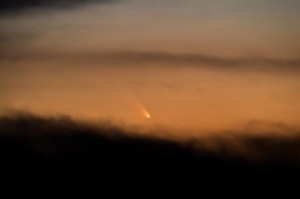Comet will be visible until the 24th–Pagasa

In this Sunday, March 10, 2013, photo taken with a 600-millimeter telephoto lens, comet Pan-STARRS appears between the clouds low in the western sky as seen from Harrells, North Carolina. Stargazers have until March 24 to catch a glimpse of the comet by taking in the Manila Bay sunset, the Philippine Atmospheric, Geophysical and Astronomical Services Administration said on Monday, March 11, 2013. AP PHOTO/THE FAYETTEVILLE OBSERVER, JOHNNY HORNE
MANILA, Philippines—Stargazers have until March 24 to catch a glimpse of the Comet Pan-STARRS or C/2011 L4 by taking in the Manila Bay sunset, the Philippine Atmospheric, Geophysical and Astronomical Services Administration (Pagasa) said on Monday.
Pagasa’s Space Sciences and Astronomy Section (SSAS) chief Dario de la Cruz said that aside from viewing one of the world’s best sunsets, stargazers may also see the comet for under an hour.
The weather bureau said the comet would be easiest to spot on Wednesday night (March 13) when it is at its highest position on the western horizon beside the crescent moon.
“Once you see the crescent moon, the comet will be on its right side. So that is the best time to observe the comet,” De la Cruz said.
Above planet Mars
Another reference point in the sky is the planet Mars. “The comet is usually somewhere above Mars,” the Pagasa official said.
Sunset on Wednesday will be at 6:06 p.m. and the comet could appear at 6:33 p.m., De la Cruz said, adding that people could wait until the sun sets and the sky darkens.
When seen with the naked eye, the comet will appear like a star with a tail on a low point of the horizon, on the spot where the sun sets.
De la Cruz explained that the comet’s appearance last Sunday marked its passage through the perihelion (point nearest to the sun) within the orbit of Mercury, making it appear brighter.
Fleeting view
Despite that, most stargazers in Metro Manila missed seeing the comet, while others only had a fleeting glimpse because of cloudy skies and the smog that covered the horizon.
Apart from Manila Bay, De la Cruz said the comet is also best viewed from the western horizon when there are no obstructions.
By March 24, the comet would have dipped lower toward the horizon, making it harder to see, although it will be visible until March 27 after sunset, he added.
According to the National Aeronautics and Space Administration (Nasa), the comet Pan-STARRS was named after the Panoramic Survey Telescope and Rapid Response System, which first spotted the heavenly body atop the Haleakala volcano in Hawaii in June 2011.
